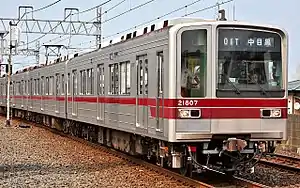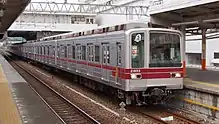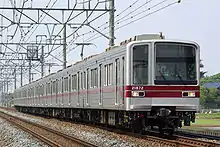Tobu 20000 series
The Tobu 20000 series (東武20000系, Tōbu 20000-kei) is a DC electric multiple unit (EMU) commuter train type operated by the private railway operator Tobu Railway in Japan since 1988.[4]
| Tobu 20000/20050/20070/20400 series | |
|---|---|
 20000 series set 21807 in June 2008 | |
| Manufacturer | Alna Kōki, Tokyu Car Corporation |
| Built at | Amagasaki, Yokohama |
| Replaced | 2000 series |
| Constructed | 1988–1997 |
| Entered service | 25 March 1988 |
| Refurbished | 2018– |
| Scrapped | 2017– |
| Number built | 192 vehicles (24 sets) |
| Number in service | 192 vehicles (24 sets) (as of 1 April 2017) |
| Formation | 8 cars per trainset |
| Operator(s) | Tobu Railway |
| Depot(s) | Kasukabe |
| Line(s) served | Tobu Skytree Line, Tobu Nikko Line, Tokyo Metro Hibiya Line, Tobu Utsunomiya Line |
| Specifications | |
| Car body construction | Stainless steel |
| Car length | 18,000 mm (59 ft 1 in) |
| Width | 2,857 mm (9 ft 4.5 in) |
| Doors | 3/5 pairs per side |
| Maximum speed | 100 km/h (60 mph)[1] 110 km/h (70 mph) (20400 series) |
| Traction system | Tо̄yo Denki Chopper Control [20000 Series] Variable frequency (Tо̄yo Denki GTO (20050, 20070 & 20400 Series) |
| Acceleration | 3.3 km/h/s |
| Deceleration | 3.7 km/h/s (service), 4.5 km/h/s (emergency) |
| Electric system(s) | 1,500 V DC overhead line |
| Current collection method | 20000 series: scissors type pantograph[3] 20070 series: single-arm pantograph[3] 20400 series: single-arm pantograph |
| Safety system(s) | Tobu ATS |
| Track gauge | 1,067 mm (3 ft 6 in) |
The 20000 series fleet is scheduled to be replaced by new Tobu 70000 series EMUs with 20 m cars.
Variants
- 20000 series: 13 x 8-car sets introduced from March 1988
- 20050 series: 8 x 8-car sets introduced from December 1992 with 5-door cars
- 20070 series: 3 x 8-car sets introduced from March 1997
- 20400 series: 4-car sets introduced from 2018 for the Tobu Utsunomiya Line
20000 series
Thirteen eight-car sets (21801 to 21813) were built to replace the ageing 2000 series trains on inter-running services between the Tobu Skytree Line and the Tokyo Metro Hibiya Line in Tokyo, entering service on 25 March 1988. The body design uses a new lightweight corrugated stainless steel construction.[4] These trains use the same AFE (Automatic Field Excite) chopper control as the earlier Tobu 9000 series trains, bolsterless bogies.[5]
Total number of vehicles built: 104[4]
20050 series

Eight eight-car sets (21851 to 21858) were introduced on 29 December 1992 on Tobu Isesaki Line (present-day Tobu Skytree Line) and Tokyo Metro Hibiya Line inter-running services. These sets feature two five-door cars at each end, and also LED destination indicators.[4] These sets have VVVF control.[1]
Total number of vehicles built: 64[4]
Formation
Trains are formed as follows, with six motored ("M") cars and two non-powered driving trailer ("Tc") cars.[3]
| Designation | Tc3 | M5 | M2 | M7 | M3 | M7 | M6 | Tc4 |
|---|---|---|---|---|---|---|---|---|
| Numbering | 21850 | 22850 | 23850 | 24850 | 25850 | 26850 | 27850 | 28850 |
The M5 and M7 cars are each fitted with one scissors type pantograph.[3]
Interior
Passenger accommodation consists of longitudinal bench seating throughout, with seats for three persons between each pair of doors in the five-door cars.[5] Seat width is 440 mm (17 in) per person for the three-person bench seats in five-door cars and 450 mm (18 in) per person for the ten-person bench seats in three-door cars.[5] As with the 9050 series EMUs introduced around the same time, these sets featured LCD passenger information screens above the doorways, but these were subsequently removed.[5]
20070 series

Three eight-car sets (21871 to 21873) were introduced from 25 March 1997 to cope with an increased service frequency. These sets feature three-door cars throughout, and also LED destination indicators.[4] These sets have VVVF control.[1]
Total number of vehicles built: 24[4]
Formation
Trains are formed as follows, with six motored ("M") cars and two non-powered driving trailer ("Tc") cars.[3]
| Designation | Tc1 | M1 | M2 | M3 | M4 | M3 | M5 | Tc2 |
|---|---|---|---|---|---|---|---|---|
| Numbering | 21870 | 22870 | 23870 | 24870 | 25870 | 26870 | 27870 | 28870 |
The M1 and M3 cars are each fitted with one single-arm pantograph.[3]
Interior
Passenger accommodation consists of longitudinal bench seating throughout. These sets feature three-colour LCD passenger information displays above alternate doorways.[5]
20400 series

The 20400 series are four-car sets for Tobu Nikko Line and Utsunomiya Line operation north of Minami-Kurihashi Station. The first trains entered revenue service on 3 September 2018.[6]
Formation
Trains are formed as follows, with two motored cars and two non-powered trailer cars. Car 1 ("Tc2") and 4 ("Tc1") are former 20000 series cars built by Alna Koki in 1988, and cars 2 ("M2") and 3 ("M1") are former 20070 series cars built by Tokyu Car in 1997. Some sets will incorporate former 20050 series cars, which will be converted from five doors to three doors per side.
| Designation | Tc2 | M2 | M1 | Tc1 |
|---|---|---|---|---|
| Numbering | 24422 | 23422 | 22422 | 21422 |
The M1 car is fitted with two single-arm pantographs.
Interior
Passenger accommodation consists of longitudinal bench seating throughout. The interior is based on the 70000 series design.
Withdrawal and refurbishment
The 20000 series trains began to be replaced by new 70000 series trains from 7 July 2017.[7] The first set to be withdrawn, set (21813 and 21809), was removed for scrapping in July 2017.[8] Some of the 20000 series trains are also refurbished as 20400 series to replace 8000 series trains.[6]
The five-door 20000 series trains are being withdrawn so that platform doors can be installed on Tokyo Metro Hibiya Line stations.
References
- 私鉄車両年鑑2015 [Japan Private Railways Annual 2015] (in Japanese). Tokyo, Japan: Ikaros Publications Ltd. 20 June 2015. p. 148. ISBN 978-4-8022-0003-5.
- 私鉄車両編成表 私鉄車両編成表 2010 [Private Railway Rolling Stock Formations - 2010]. Japan: JRR. August 2010. p. 36. ISBN 978-4-330-15310-0.
- 2006東武鉄道通勤車両カタログ [2006 Tobu Railway Commuter Rolling Stock Catalogue]. Tetsudo Daiya Joho Magazine. Vol. 35 no. 263. Japan: Kotsu Shimbun. March 2006. pp. 16–20.
- 東武鉄道の世界 [The World of Tobu Railway] (in Japanese). Japan: Kotsu Shimbunsha. 8 April 2015. p. 41–43. ISBN 978-4-330-54215-7.
- Saito, Takahisa (4 September 2018). 東武20400形が営業運転を開始 [Tobu 20400 series starts commercial operation]. Japan Railfan Magazine Online (in Japanese). Japan: Koyusha Co., Ltd. Archived from the original on 10 February 2019. Retrieved 10 February 2019.
- "新型車両70000系運行開始【HP用確定版】" (PDF). 22 June 2017. Archived from the original (PDF) on 7 October 2017.
- "東武鉄道20000系が渡瀬へ" [Tobu Railway 20000 series to Watase]. Japan Railfan Magazine Online. Koyusha Co., Ltd. 29 July 2017. Archived from the original on 10 February 2019.
External links
| Wikimedia Commons has media related to Tobu 20000 series. |
- Tobu 20000 series (in Japanese)
